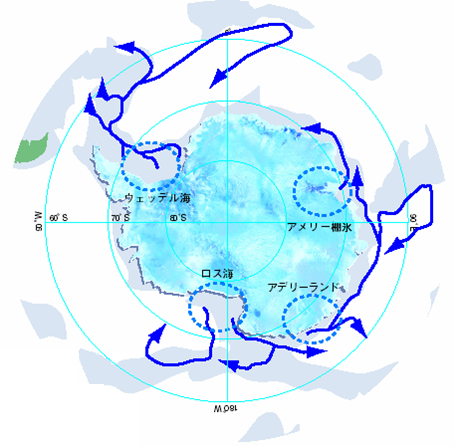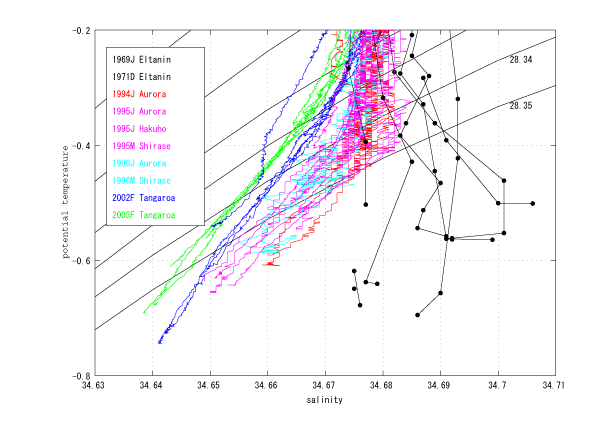Polar Oceanography
Adelie Land Bottom Water

Antarctic bottom water is, along with North Atlantic deep water, a source of deep and bottom water for all the world's oceans. The amount of Antarctic bottom water generated governs the relative strength of global deep ocean circulation. The Weddell and Ross Seas are well known regions of Antarctic bottom water formation, but in recent years it has emerged that the waters off Adelie Land in the vicinity of East 140 degrees Longitude is also an important region for bottom water generation (Refer to right figure).
In partnership with domestic and international research institutions, the University of Hokkaido has conducted oceanographic surveys in the waters off Adelie Land, and revealed variations in this bottom water. The below figure illustrates variations in water temperature and salinity in bottom water from 1969 to 2003, and demonstrates that salinity is dropping. This change indicates a high possibility that deep water circulation is in a weakening trend, thus it is necessary to conduct even more careful observation going forward.

Courtesy of S. Aoki
Seeking Undiscovered Antarctic Bottom Water Formation Regions
When sea ice (ice from frozen sea water) is formed, the majority of salt in the seawater is expelled from the ice, so heavy water with high salinity is produced. A great quantity of sea ice is produced near the Antarctic coast, so the heavy water created by this process sinks to the sea floor and expands throughout the world's sea floor as the world's heaviest seawater; the Antarctic bottom water. Heavy water is produced where a large amount of sea ice is produced. But it is not well understood where and how much sea ice is being produced. The below figure illustrates the first spatial distribution (mapping) of annual sea ice production levels in the Antarctic by combining satellite data and site survey and meteorological data. The body of water with the highest sea ice production is the Ross Sea, which corresponds well with this area being the production area of the Antarctic bottom water with the highest salinity. It is also understood that second to the Ross Sea, the region of highest sea ice production is approximately 1200 km East of Japan's Showa South Pole Base. It has been suggested that this may be an undiscovered Antarctic bottom water generation region, so intensive observation began in 2008 to confirm this possibility.

|
Figure: Mapping of annual quantity survey of sea ice production levels in Antarctic Sea (converted in thickness). Partial alterations of Tamura, Ohshima, and Nihashi (2008) |
References
The below links serve as useful references


